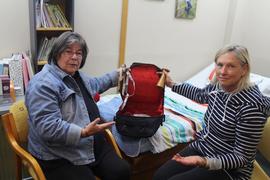Midwives feeling vulnerable
Claire Kaplan
16 April 2019, 6:00 PM
 Midwives Nicky Pealing (left) and Jo Lundman show the size of a basic birthing kit in Te Anau that they say for now, is empty. Mrs Lundman is covered for four days a month by another midwife, but she said the DHB had yet to provide this midwife with supplies like a basic birthing kit. For now, Mrs Lundman has been lending her own. PHOTO: Claire Kaplan
Midwives Nicky Pealing (left) and Jo Lundman show the size of a basic birthing kit in Te Anau that they say for now, is empty. Mrs Lundman is covered for four days a month by another midwife, but she said the DHB had yet to provide this midwife with supplies like a basic birthing kit. For now, Mrs Lundman has been lending her own. PHOTO: Claire KaplanNo birthing bed, no antibiotics and only basic birthing supplies on hand: midwives say they've been left with an "empty shell of a building" at Lumsden Maternity with no clear plan moving forward.
It's been more than a year since the Southern DHB first announced its plan to eliminate birthing services at Lumsden Maternity Centre, which officially took effect on Monday (April 15).
But before this week, one room was absent a birthing bed. Lumsden midwife Nicky Pealing said there were also no antibiotics, only basic supplies for births, and the cabinets holding oxygen for the emergency resuscitation were empty.
At the moment, the building felt like an "empty shell of a building" according to Lumsden midwife Sarah Stokes.
The midwives most directly affected by the downgrade, such as Mrs Stokes and Mrs Pealing, say they're as in the dark as ever about how the centre will be used in its new life as a "Maternal and Child Hub", what supplies it will have, and when they'll come in.
Mrs Pealing, who works with Mrs Stokes to provide postnatal services, said despite the time that has gone past since the downgrade announcement and "despite all the discussions they've had with the building people and the GPs, here we are: it's closed now and there's nothing in place. And these gaps are massive."
Central to those gaps was the 24/7 on-call midwife at Lumsden that could support Mrs Stokes and Te Anau midwife Jo Lundman during a birth in the Lumsden area, or cover an urgent matter if both of them were away attending patients in the wide radius elsewhere.
That service, for now, is gone, leaving the midwives in what Mrs Stokes described as a vulnerable position.

"I think when you're in a bigger town, where there's more community midwives working, it's easy to cover each other. You feel quite vulnerable being here in Lumsden or Te Anau and you're providing care for one of your clients down in Invercargill, because that's where they have to birth. And then you know that you could have other clients that have urgent matters that you need to attend to in Lumsden or Te Anau region," Mrs Stokes said.
"It was always really great that you knew the facility midwife was there, that you could ring her, she could see the woman and just put your mind at ease really."
Other gaps midwives identified to the DHB months earlier included no 24/7 breastfeeding support available to women after being discharged from their birth, or no Te Anau GPs having a diploma in obstetrics and gynecology.
Southern DHB executive director, strategy, primary and community Lisa Gestro said lead maternity carer (LMC) midwives had backup midwife arrangements, as required by their service specification with the Ministry of Health.
The Southern DHB was also providing relief midwife support for Mrs Lundman, and sustainability payments for each remote-living woman that the LMC midwives booked.
"We will continue to work with the LMCs and others in the community to look at what other options might be feasible, including the possibility of community midwifery support in addition to the co-ordination function for the local centre," she said.
According to Mrs Lundman, the midwife meant to cover her so she could take four days off a month still didn't have supplies such as a homebirth kit and scales, which the DHB was supposed to supply.
Mrs Gestro said they were currently recruiting a part-time hub coordinator with the support of Gore Health, and that a qualified Southern DHB employed midwife would act as the hub coordinator until the role is filled.
However, Mrs Pealing said she hadn't even seen a job description of the position, let alone see it advertised. Mrs Lundman said it had been an overall disorganised effort.
"I'm just bewildered and lost by something that they've had so much time to prepare for and yet haven't," Mrs Lundman said.
New Zealand College of Midwives midwifery adviser for quality assurance Jacqui Anderson attended an April meeting among the DHB, midwives, trustees of the maternity centre building, the Ministry of Health.
From that meeting, she said the DHB had ideas for what they were going to do next, but really none of those ideas had been particularly established before the downgrade.
Not only did it leave the midwives not knowing where they stood and what kind of support they would have, it left the women and babies not knowing what kind of services were available.
"It seemed that whilst the DHB said that they had some alternatives, those alternatives were not in place. How can you stop a service, not have something in place, and then say, 'Well, we'll get around to it?'
"That's really putting those midwives in an extremely untenable and potentially unsafe position."